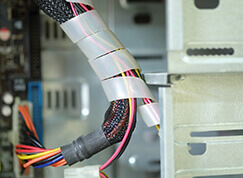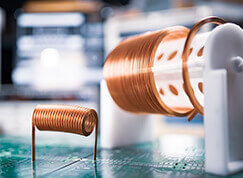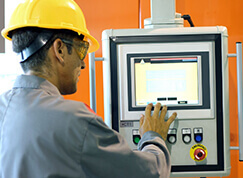What Is An Induction Heating System?
Induction heating systems offer many advantages including fast, precise heating, energy efficiency, minimal heat loss, and versatility for various industrial applications such as metal heat treatment, brazing, welding, and induction forging.
Our induction heaters convert AC line power to higher frequency AC power, which is delivered via specially designed cables to a work head containing an array of capacitors and custom designed work coils. This combination uses the principle of resonance to generate an electromagnetic field within the coil to efficiently transfer energy to the workpiece.
What does a typical induction heating system consist of?
A typical induction heating system consists of several key components that work together to generate and control the electromagnetic induction process for heating purposes. These components include:

Power Supply
The power supply is the heart of the induction heating system. It converts electrical energy from a mains source to high frequency alternating current (AC) or radio frequency (RF) power. The power source determines the frequency of the alternating current, which is critical for penetration depth and heating rate.

Induction Coil
The induction coil is a critical part of the system and is usually made of copper or other conductive material. It is designed in a specific shape and configuration to surround or surround the workpiece being heated. When high frequency AC or RF current is passed through the coil, a rapidly alternating magnetic field is generated.

Workpiece (Load)
The workpiece, also known as the load, is the material or part that needs to be heated or processed using an induction heating system. It is placed inside the induction coil, and the alternating magnetic field induces eddy currents in the workpiece, making it heated quickly and evenly.

Heat Exchanger/Cooling System
Induction heating generates intense heat, especially in the induction coil. To keep the temperature of critical components within the safe operating range, a heat exchanger or cooling system is integrated into the system. This system helps dissipate excess heat and ensures the longevity and reliability of the equipment.

Temperature Sensors
Temperature sensors, such as thermocouples or infrared sensors, are used to monitor and control the heating process. They measure the temperature of the workpiece and provide feedback to the control system, allowing precise temperature control and avoiding overheating.

Water Cooling System
In order to keep the induction coil and some other components at a safe operating temperature, a water cooling system is usually used. It circulates water through cooling channels to dissipate the heat generated during operation.

Safety Interlock Device
The induction heating system is equipped with a safety interlock device and protection device to ensure safe operation and prevent damage to equipment and workpieces in the event of failure or abnormal conditions. These interlocks may include overcurrent protection, overtemperature protection, and fault detection systems.

User Interface
Provides the operator with a user interface to control and adjust heating parameters, monitor the heating process, and access diagnostic information. The interface allows the user to enter heating parameters, set the temperature profile and start or stop the heating process as desired.
Induction heating power supplies send alternating current through an induction coil, which creates a magnetic field. When a workpiece is placed within the coil and enters the magnetic field, eddy currents are induced within the workpiece. The friction created by these currents produces precise, clean, non-contact heating. A water cooling system is generally required to cool the working coils and the induction heating system.
 Whatsapp
Whatsapp
